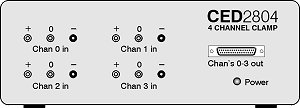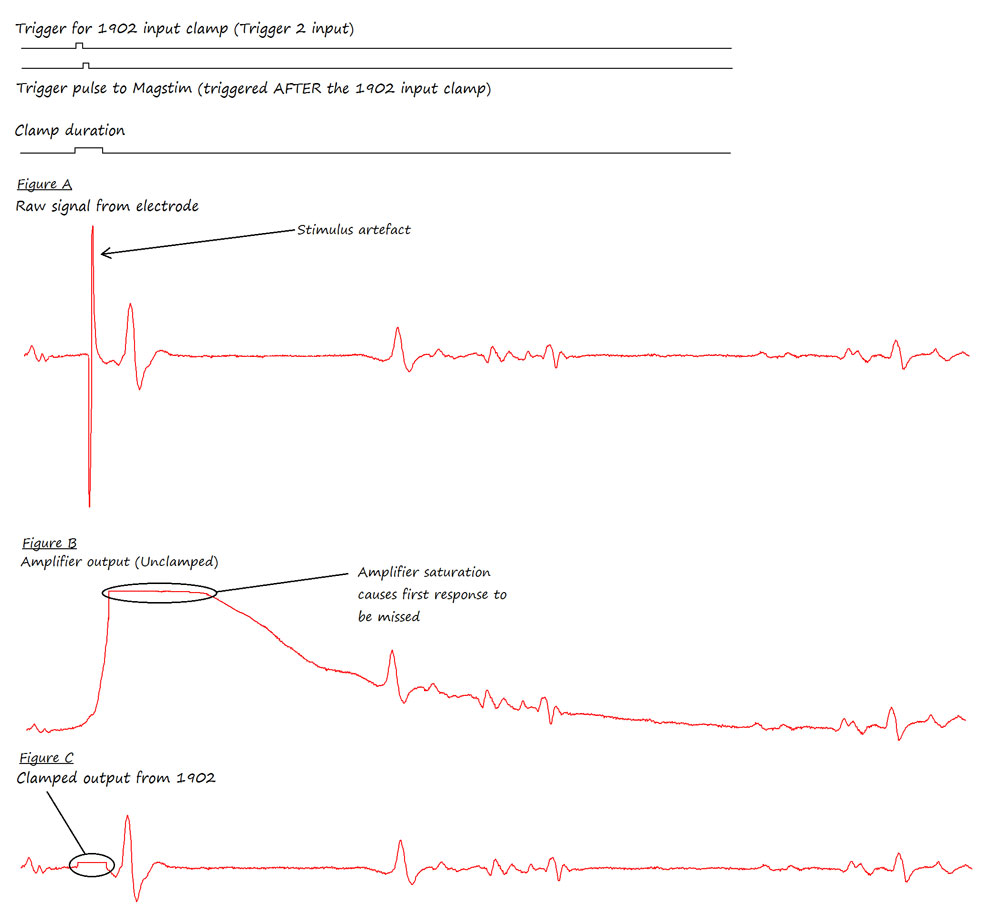1902 input clamp option
The input clamp option is designed for use with triggered subject stimulation where the stimulus would otherwise overload the 1902 amplifier input stages. Such overloads may not be electrically damaging, but the amplifier may take several seconds to regain normal operation after an overload, thus making it difficult to measure fast subject responses to the stimulus.
The types of stimulus where clamping can be useful include fast magnetic field changes and electrical (somatosensory) pulses.
The 1902 low-noise EEG input has been shown in its unclamped form to be as good as or better than other commercially available isolated amplifiers when dealing with this type of stimulus. In experimental situations where, for example, EMG recordings are taken from the hand during magnetic stimulation to the brain, clamping is generally not necessary. However, when very fast responses (e.g. 2-10 milliseconds after stimulation) are to be measured, or recordings taken from the facial area during stimulation to the head, then input clamping can prevent amplifier input saturation and allow these recordings to be made successfully.
How does the clamp work?
The 1902-4C clamp input has special switching circuits that operate at the isolated electrode input. The switches are opened and closed by a timing unit that is in turn triggered by a trigger pulse at the Trigger2 front panel input.
The timing unit can generate pulses in the range 0.5 to 14 milliseconds. The length of pulse is determined by the input source selected by software. On receipt of a positive-going edge on the Trigger2 input, the timing unit generates a pulse of the selected length. This pulse operates switches that disconnect the electrode inputs from the input amplifier and instead connect the signal electrode inputs via a low resistance to the common electrode.
At the same time, the amplifier inputs are connected to a local signal source. This is normally ground, but can be a low-pass filtered version of the input signal. During the length of the timing pulse, the inputs will appear to be "clamped" either to ground or to an average value of the input during the last few milliseconds. At the end of the timing period, the input is "unclamped" and the amplifier will jump to a state representing the new value of the inputs.
There is a four-channel version of the clamp option in a free-standing box, model 2804, described below, with similar functionality that can be used with other amplifiers.
The 2804 clamp box
The model 2804 unit is designed to be used between surface electrodes and an electrode amplifier. Its purpose is to limit large predictable input excursions such as over-range voltages or magnetically induced artefacts that would otherwise cause overload or saturation conditions in the amplifier. The unit has 4 isolated differential channel pairs which are clamped simultaneously.

To clamp the circuit the unit expects to receive a TTL (digital) trigger signal from external equipment such as a CED1401 or pulse generator. When the trigger is seen the clamp comes into effect for the duration of the trigger pulse, contrast the 1902-4C clamp option, which is self-timed. There are selectable operating modes to cater for different electrode configurations and experimental conditions.
The unit is sold as research equipment and is designed to meet EN 60601-1. However, it is the user’s responsibility to ensure that the CED 2804 conforms to any additional safety requirements applicable to the intended type of use.
Registered in England: 00972132
Registered office:
- Cambridge Electronic Design Limited,
- Technical Centre,
- 139 Cambridge Road,
- Milton,
- Cambridge CB24 6AZ
- ENGLAND.
VAT: GB 214 2617 96
Producer registration number: WEE/BD0050TZ
For our US customers, we can provide tax form W-8BEN, that identifies us as a UK company.
UEI : EQ4LMQ1M2ZS5
CAGE/NCAGE: KB797
NAICS: 423490
Hardware: 84716070
Software: 85235190
By email:
By post:
- Cambridge Electronic Design Limited,
- Technical Centre,
- 139 Cambridge Road,
- Milton,
- Cambridge CB24 6AZ
- ENGLAND.
By telephone:
(Int.+44) (0)1223 420186
From North America (Toll Free):
1 800 345 7794










